4
Figure 1.4 The Optical Center of the Lidar
2. Electrical Interface
2.1 Power Supply
The power input range of the CH128X1 Lidar is 9V~36VDC. If other DC power
supply is adopted, the recommended output voltage of the power supply is
12VDC, 19VDC or 24VDC. Please note that DC 9V and 36V are short-term
power supply in extreme environment, which cannot be used as working voltage.
When the voltage output fluctuates, the Lidar may not be able to work normally.
The maximum output current should be ≥2A (the Lidar requires a large
instantaneous current when starting, and a small starting current may cause its
failure to start normally). The output ripple noise should be <120 mVp-p and
output voltage accuracy <5%. It is recommended to use 12V/3A or 24V/2A
power adapter.
The higher the power supply voltage and the stronger the discharge capacity,
the more severe the impact on the Lidar (such as powered by direct vehicle
power supply without adapters and interface boxes). Therefore, it is necessary
to use high-power TVS transient suppression diodes to protect the Lidar to avoid
damage.
The line length of the Lidar power supply is 5~10 m, and the power supply
voltage needs to be over 19V. If the line length is more than 10 m, then it is

